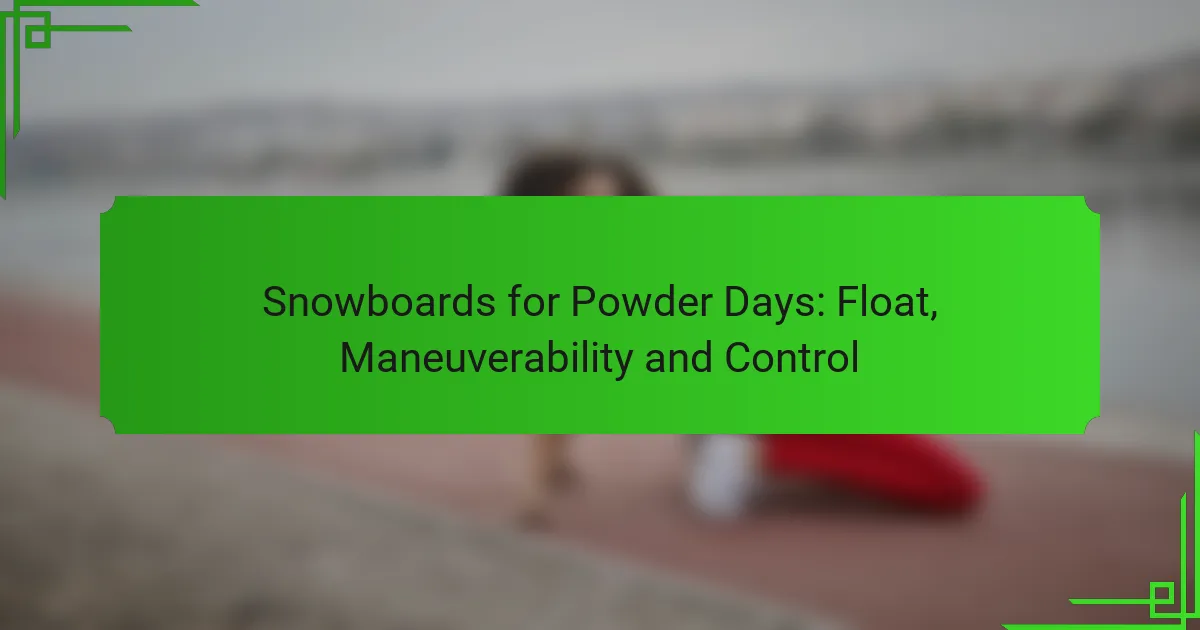Snowboards crafted for powder days are essential for riders seeking optimal float, maneuverability, and control in deep snow. These boards typically incorporate wider noses, tapered tails, and specialized rocker profiles to enhance buoyancy and responsiveness, allowing for seamless navigation through soft terrain. Understanding the importance of design elements like width, sidecut radius, and flex patterns can significantly improve your experience on powder days.

Which Snowboards Are Best for Powder Days?
Snowboards designed for powder days prioritize float, maneuverability, and control, enabling riders to navigate deep snow effectively. The best options typically feature wider noses, tapered tails, and rocker profiles that enhance buoyancy and responsiveness.
Burton Fish 158
The Burton Fish 158 is a standout for powder riding, thanks to its directional shape and unique swallowtail design. This board excels in deep snow, providing excellent float and stability while allowing for quick turns and smooth transitions.
With a medium flex, the Fish balances playfulness and control, making it suitable for both experienced riders and those looking to improve their powder skills. Its lightweight construction enhances maneuverability, ensuring you can navigate tight trees and open bowls with ease.
Lib Tech T.Rice Pro
The Lib Tech T.Rice Pro is designed for versatility in various snow conditions, including powder. Its C2X hybrid rocker profile offers a perfect blend of float and edge control, making it easy to ride in deep snow while still performing well on groomed runs.
This board features a slightly stiffer flex, which provides stability at high speeds and during aggressive turns. Riders appreciate its eco-friendly construction and durability, making it a solid investment for those who frequently tackle powder days.
Jones Hovercraft
The Jones Hovercraft is engineered specifically for powder, featuring a wide nose and a tapered tail that enhance floatation. Its directional shape allows for effortless glide over deep snow, while the rocker profile helps maintain speed and control.
This board is particularly well-suited for backcountry adventures, as it handles variable conditions with confidence. Riders often praise its ability to carve through powder while remaining agile enough for quick direction changes.
Salomon Powder Snake
The Salomon Powder Snake is a playful option for powder enthusiasts, featuring a wide platform that enhances float. Its unique shape and rocker profile make it easy to maneuver in deep snow, allowing for creative turns and tricks.
With a softer flex, this board is ideal for riders who enjoy a more surf-like feel in powder. It’s a great choice for those looking to explore off-piste terrain without sacrificing fun and responsiveness.
Capita Spring Break Slush Slasher
The Capita Spring Break Slush Slasher is designed for playful powder riding, with a wide nose and a short length that enhances maneuverability. This board excels in soft snow, providing ample float and a fun, surfy ride.
Its unique design allows for easy turns and quick transitions, making it perfect for navigating through trees or open bowls. Riders appreciate its versatility, as it performs well in slushy conditions as well, making it a great all-around choice for varying snow types.

How Do Snowboard Designs Affect Float in Powder?
Snowboard designs significantly influence float in powder by determining how well the board stays on top of soft snow. Key design elements such as width, rocker profiles, and length all contribute to a board’s ability to maneuver and maintain control in deep snow conditions.
Wider Nose and Tail Shapes
Wider nose and tail shapes enhance float by increasing the surface area of the snowboard. This design allows the board to distribute weight more evenly across the snow, preventing it from sinking. A board with a wider nose is particularly beneficial for initiating turns and maintaining speed in powder.
When selecting a snowboard, consider models with a tapered shape, where the nose is wider than the tail. This design helps the board rise in powder, making it easier to navigate through deep snow without losing momentum.
Rocker Profiles
Rocker profiles, which refer to the curvature of the snowboard, play a crucial role in floatation. Boards with a pronounced rocker, or reverse camber, lift the nose off the snow, allowing for better maneuverability and less resistance in powder. This design helps riders maintain speed and control while navigating through soft snow.
For optimal performance in powder, look for boards with a combination of rocker in the nose and a flat or slightly cambered tail. This setup provides a balance of float and stability, making it easier to execute turns and maintain control in challenging conditions.
Length Considerations
The length of a snowboard can also impact its float in powder. Generally, longer boards offer better float due to their increased surface area, while shorter boards provide enhanced maneuverability. Riders should choose a length that aligns with their skill level and riding style.
A good rule of thumb is to select a board that reaches somewhere between the rider’s chin and nose when standing upright. This length typically offers a balance of float and control, making it suitable for various powder conditions.

What Features Enhance Maneuverability in Powder?
Key features that enhance maneuverability in powder include sidecut radius, flex patterns, and weight distribution. Each of these elements plays a significant role in how well a snowboard can float, turn, and maintain control in deep snow conditions.
Sidecut Radius
The sidecut radius refers to the curvature of the snowboard’s edge. A smaller radius allows for tighter turns, which is beneficial in powder where quick maneuvering is often necessary. For powder riding, boards with a sidecut radius ranging from 6 to 8 meters can provide a good balance between agility and stability.
However, boards with a larger radius may offer better straight-line speed and floatation. Riders should consider their style and the type of terrain they frequent when selecting a board’s sidecut radius.
Flex Patterns
Flex patterns determine how a snowboard responds to rider input. Softer flex boards are generally more forgiving and easier to maneuver in powder, allowing for playful turns and quick adjustments. A medium flex pattern, typically found in all-mountain boards, offers a balance of control and responsiveness, making it suitable for varied conditions.
Riders should assess their skill level and riding style when choosing flex patterns. Beginners may benefit from softer boards, while advanced riders might prefer stiffer boards for enhanced performance in challenging powder conditions.
Weight Distribution
Weight distribution on a snowboard affects its ability to float in powder. Boards designed with a set-back stance, where the bindings are positioned further back, help keep the nose elevated, improving floatation. This design is particularly useful in deep snow, as it allows for easier navigation and less effort when turning.
Additionally, some boards feature a tapered shape, where the tail is narrower than the nose, further enhancing floatation and maneuverability. Riders should consider their weight and the board’s design to optimize performance in powder conditions.

How to Choose the Right Snowboard for Control?
To choose the right snowboard for control, focus on factors like stiffness ratings, binding compatibility, and your personal riding style. These elements significantly impact how well you can maneuver and maintain stability on the slopes.
Stiffness Ratings
Stiffness ratings indicate how flexible or rigid a snowboard is, affecting its control and responsiveness. A stiffer board generally provides better stability at high speeds and is ideal for aggressive riding, while a softer board offers easier maneuverability and is better for beginners or those who prefer a more playful style.
Most snowboards range from soft (around 1-3) to stiff (7-10) on the stiffness scale. If you often ride in powder, consider a medium to stiff board for better floatation and control in varied conditions.
Binding Compatibility
Binding compatibility is crucial for ensuring your snowboard setup functions effectively. Check that your bindings fit the board’s mounting system, which can vary between brands and models. Most boards use either 4-hole or channel systems.
When selecting bindings, consider the flex and responsiveness that match your board’s stiffness. Mismatched bindings can lead to poor control and an uncomfortable ride, especially on powder days.
Personal Riding Style
Your personal riding style plays a significant role in choosing the right snowboard for control. If you enjoy carving and high-speed runs, opt for a stiffer board that offers precision. Conversely, if you prefer freestyle tricks or riding in trees, a softer board may enhance your agility.
Think about where you typically ride and the conditions you encounter. For powder days, a board designed for floatation and maneuverability will enhance your experience, allowing for smoother turns and better control in deep snow.

What Are the Key Attributes of Powder-Specific Snowboards?
Powder-specific snowboards are designed to excel in deep snow conditions, prioritizing floatation, maneuverability, and control. These attributes enable riders to navigate powder effectively, enhancing the overall experience on the slopes.
Floatation
Floatation refers to a snowboard’s ability to stay on top of soft, deep snow rather than sinking. This is crucial for powder days, as it allows riders to glide smoothly without getting bogged down. Snowboards with a wider nose and a tapered tail typically offer better floatation.
To maximize floatation, look for boards with a significant rocker profile, which raises the tip and tail, helping the board to stay above the snow. A board length that is slightly longer than your standard all-mountain board can also enhance floatation, providing more surface area to distribute weight.
Common pitfalls include choosing a board that is too short or too stiff, which can hinder floatation. Opt for boards that are specifically labeled for powder use, as they are engineered to provide the best performance in these conditions.
Maneuverability
Maneuverability is the snowboard’s responsiveness and ease of turning, especially in tight spaces or when navigating through trees. Powder-specific boards often feature a shorter effective edge and a wider nose, allowing for quicker turns and better handling in deep snow.
When selecting a board for maneuverability, consider those with a more pronounced sidecut radius. A tighter sidecut allows for sharper turns, which is beneficial in variable terrain. Additionally, a lightweight construction can improve responsiveness, making it easier to shift your weight and change direction.
A common mistake is choosing a board that prioritizes stability over maneuverability, which can make turning cumbersome in powder. Test different models to find the right balance that suits your riding style and the terrain you frequent.
Control
Control in powder snowboarding refers to how well a rider can steer and manage their speed. A board that offers good control will provide a stable ride while allowing for precise adjustments as conditions change. Features like a stiffer flex and a directional shape contribute to enhanced control.
For optimal control, look for boards with a balanced flex pattern that supports both stability and responsiveness. This helps in maintaining edge hold while navigating through varied snow conditions. Additionally, boards with a setback stance can improve control by shifting the rider’s weight towards the tail, enhancing stability in deep snow.
A common error is opting for overly soft boards, which can lead to a lack of control at higher speeds. Ensure that the board’s flex matches your skill level and riding style to maintain the best control on powder days.
